4. Transporting Scotland's Freight
Transporting Scotland's Trade 2019 Edition
4. Transporting Scotland's Freight
Scotland's transport network supported over £57.6 billion worth of international trade in goods in 2018[22]. This was a 9% increase in the value of trade in Scotland, from £52.8 billion in 2017.
However, tracing Scotland's exports and imports continues to be challenging for a number of reasons. Official data on the volume of Scotland's trade in goods carried by different modes of transport is often collected and published by different organisations which can make aggregation and comparison difficult. Additionally, some data concerning trade flows and transportation is only published at a UK level, and is therefore difficult or impossible to disaggregate to a Scottish level.
Moreover, the methodology for counting Scottish exports may differ from that for aggregate totals due to the treatment of goods which move from Scottish ports to offshore oil facilities. A significant proportion of Scottish trade is shipped via a number of countries before arriving at its final destination. For example, as discussed earlier, the Netherlands is the largest export market for Scottish goods, largely due to the Rotterdam effect. Some exporters may not know the final destination of their goods, and this is reflected in the trade statistics.
Finally, accounting techniques are sometimes employed to move goods between company headquarters around the world, and so while goods and services may be exported and imported based on company balance sheets, occasionally the physical goods may not 'travel' anywhere, with services being even more difficult to follow.
Scotland continues to have strong trade links to a number of countries overseas – actively trading with over 105 countries across nearly 100 different industries and sectors[23]. One example is the food and drink sector which totalled £9.8 billion worth of exports in 2014, with fish and seafood making up the largest share of food exports that year.
Scottish seafood companies which export perishable goods often rely on frequent transport links to enable a fluid production process. Salmon is Scotland's number one food export, with trade extending to more than 65 countries around the world. While the Scottish Salmon Company (SSC), one of the largest producers of salmon in Scotland, relies heavily on the road network and air links for the transportation of their goods, many fishermen also utilise Scottish ports to move their cargo. This edition therefore looks in more detail at the movement of fish directly from Scottish ports.
The remainder of this chapter will examine Scotland's key transport gateways and networks – namely Scotland's airports, ports, roads and railways.
4.1 Key Transport Gateways and Networks
All of the four main modes - road, rail, sea and air - are key to Scotland's transport network, with some being more significant than others. The vast majority of Scotland's freight is carried on land either through its extensive road network which consists of over 56,000 km of road, or its railways with a total route length of 2,819 km, over a quarter of which is electrified. Of the Scottish road network, 20% are major roads (including trunk and non-trunk 'A' roads), with only 1% of the trunk road network being comprised of motorways[24].
Scotland's primary trunk road link to the rest of Great Britain is across the M74 and M6 across the Scotland England border. Other routes that cross the border include the, A1 north of Berwick, the A6105 a few miles to the west, the A697 at Coldstream, the A68 at Carter Bar and the A7 north of Longtown. Once in England, there are a number of transport corridors to the Channel Tunnel and Channel Ports which facilitate onward travel into continental Europe.
Approximately 214 million tonnes (road, port and air) of freight was lifted in Scotland in 2018. The large share of this was carried on Scottish roads[25] with a final destination in Scotland. In 2018, an estimated 148.5 million tonnes of goods were transported on Scottish roads by UK HGVs. In 2018, 87% (111.4 million tonnes) of goods lifted for road freight journeys originating in Scotland also ended their journey in Scotland, while 13% were destined for other UK destinations (not including Scotland), 97% of which had a final destination in England, the North West being the most popular destination.
It is thought less than 1% of road freight originating in Scotland had an international destination. However, there is currently no definitive source of data for the total market for Scottish road freight to abroad as there are issues with defining the destination of HGVs leaving Scotland via England and pinpointing what proportion of freight sailings from English ports originated in Scotland[26], particularly if cargo moves or is loaded onto another vessel.
Scotland's main passenger airports are Edinburgh, Glasgow, Aberdeen and Inverness, while the main freight airports are Edinburgh, Glasgow and Glasgow Prestwick. Major Scottish ports[27] include Aberdeen, Cairnryan, Clyde, Cromarty Firth, Dundee, Forth, Glensanda, Orkney, Peterhead, Loch Ryan and Sullom Voe.
The Scottish railway network consists of 358 passenger stations and 81 freight terminals and yards[28]. The main rail freight terminals in Scotland are across the central belt and going from east to west include Grangemouth, Mossend, Coatbridge, Deanside (Hillington) and Elderslie. While Scottish rail freight volumes are unable to be included in the above total due to limitations in data collection, in Great Britain in 2017, 5% of all freight lifted was on rail[29], which was largely unchanged from the previous year.
The following sections provides further information on freight carried by the key modes and the location of the key hubs in Scotland.
4.2 Air Connectivity
Figure 9: Scotland's Main Airports with Passenger Numbers and Freight Carried (2018)
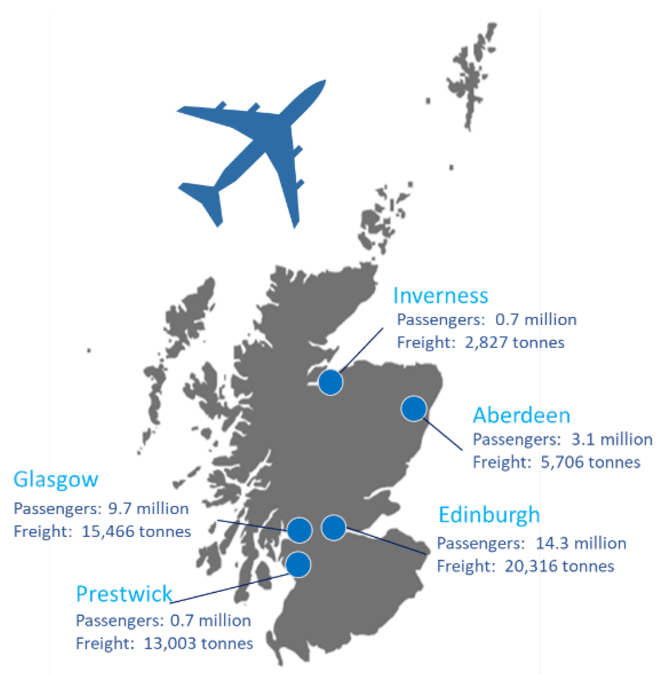
The figure above shows Scotland's five main airports by freight (total lifted, inwards and outwards) and passenger numbers in 2018[30]. That year, freight carried by air in Scotland totalled over 62,000 tonnes. Air freight makes up a tiny share of total freight lifted in Scotland, however, goods being transported by air tend to be of a higher value, less bulky and more time sensitive than those transported by sea.
Although Scotland's airports are primarily used for passenger journeys, air freight remains important to Scotland's trade market. Scottish air freight volumes fell in 2018 by around 3% from the previous year, reversing slightly the general upward trend since reaching a low of 45,000 tonnes in 2011. As Scottish companies require the timely movement of certain types of goods, it is likely that the air freight industry will continue to be important to Scotland's export industry and therefore a crucial part of Scotland's wider transport network.
The chart below (Figure 10) shows how air freight volumes have changed over time by airport. From a recent peak in 2006, they had fallen by over 45% by 2011, with the largest fall coming between 2007 and 2008. This can be partly explained by the global financial crisis and its impact on demand for Scottish goods in overseas markets, thereby weighing on Scottish economic performance. Freight volumes have steadily increased since 2011. Scotland's top airport for both freight and passenger numbers is Edinburgh Airport, which continues to be the UK's 6th busiest airport.
Figure 10: Tonnage of Air Freight Handled by Scottish Airport - 2018
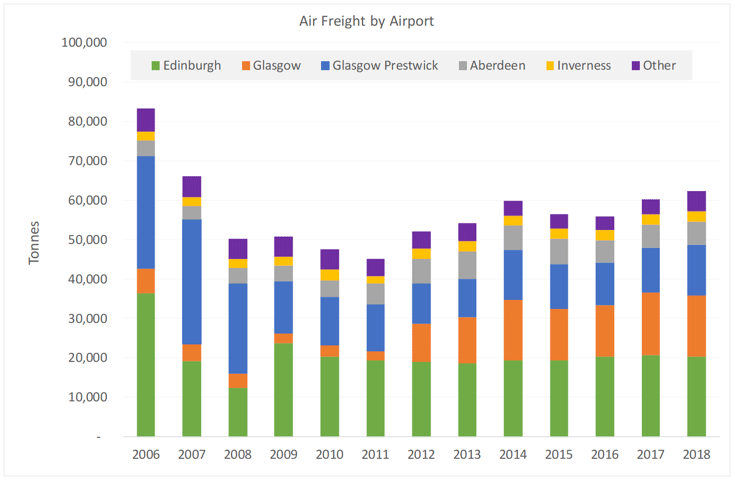
*Other Airports includes Barra, Benbecula, Campbeltown, Dundee, Islay, Kirkwall, Lerwick (Tingwall), Scatsta, Stornoway, Sumburgh, Tiree, Unst, and Wick John O'Groats.
Air Freight Vessel Type
Scottish producers wishing to move goods via air freight can do so in one of four ways. Firstly, there is the choice between a cargo plane and a passenger plane. Cargo planes are strictly for goods and therefore have larger capacities than passenger aircraft.
Secondly, producers can choose between whether they charter a service for their goods, or they utilise a service which is already running, a scheduled service, to move their freight.
There are often more passenger planes leaving from Scottish airports than cargo flights, however, by proportions, approximately two thirds (67.6%) of all air freight lifted at Scottish airports is lifted in cargo planes with about third (32.4%) of freight travelling in passenger planes.
The split between scheduled flights and chartered flights is similar. In 2018, approximately 68% of all air freight lifted in Scottish airports, used a scheduled service which was already planned and running. Over 40% of these scheduled flights left from Glasgow Airport. Chartered flights for freight made up the minority, accounting for 32%.
Combining the two and looking at the options available, the data shows that air freight in Scotland is most likely to travel on a scheduled cargo plane than any other aircraft. These account for 39% of all freight carried by air. The next most common option was scheduled passenger, which accounted for 28% of air freight lifted from Scottish airports. This is shown in Figure 11 below.
Figure 11: Air Freight through Scottish Airports by Aircraft Type - 2018
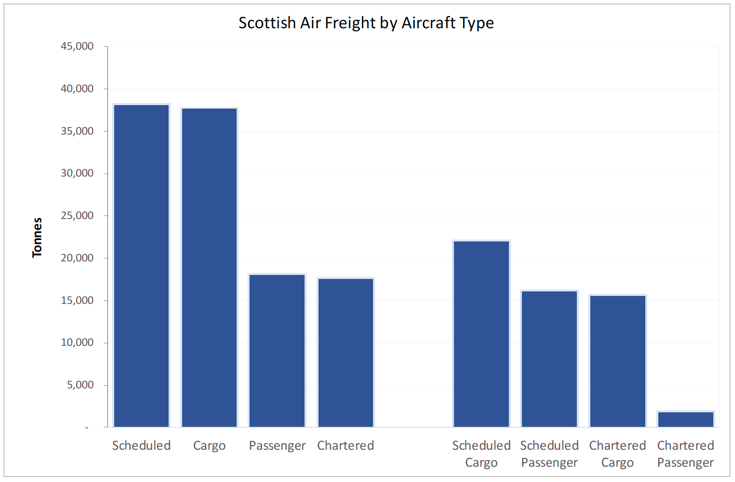
In 2018, there were 29.4 million air terminal passengers travelling from all Scottish airports, 0.6 million (2.1%) more than the previous year. Passenger numbers have increased year-on-year since 2010, and have grown by 5.1 million (21%) in the last decade.
From Scotland's airports it is possible to access 56 countries (excluding other UK destinations) and over 220 destinations directly. Scotland's most popular destination for the last decade has been Spain, with passenger numbers (including the Canary Islands) in 2018 over 4 million, accounting for nearly a quarter of all air passengers of direct journeys abroad that year. Edinburgh Airport had 14.3 million terminal passengers in 2018 and Glasgow Airport had 9.7 million. Together, the top four airports (Edinburgh, Glasgow, Aberdeen and Inverness) accounted for nearly 95% of total terminal passengers.
The CAA publish data on the movement of international terminal passengers. The chart below shows the breakdown of international travel between EU and other international terminal passengers for Scotland's five busiest airports.
Figure 12: EU and Other International Passengers by Scottish Airport – 2018
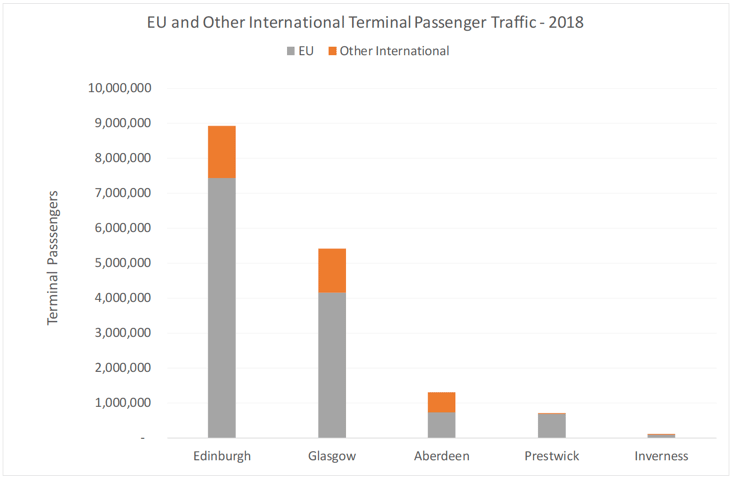
Of the international flights made in 2018, the majority of terminal passengers were bound for the EU. The number of EU bound passengers fell slightly from 2017 levels for Aberdeen, Glasgow and Prestwick airports, while Edinburgh and Inverness saw their number of EU bound terminal passengers increase over the year.
4.3 Port Connectivity
Scottish ports are fundamental to the Scottish economy. They play a unique role in providing a base for trade and employment. They also provide the landside gateways for vital industries such as offshore energy, fishing and cruise sectors. They handle a wide range of cargo, with an array of dry bulk, liquid bulk and other cargo goods entering and leaving the country through ports every day.
Approximately 30% of Scotland's total freight (excluding rail and pipeline) was handled by Scotland's sea ports in 2018. Latest data[31] shows that foreign and domestic sea port freight traffic across all ports in Scotland totalled 65.4 million tonnes in 2018, as shown in Figure 13. Forth and Clyde Ports combined handled over half (55%) of this freight. The volume of sea freight fell slightly compared to 2017, continuing the downward trend of the past decade. Since 2008, Scottish port volumes have fallen by 32%[32].
Figure 13: Total Freight Tonnage time series – All Scottish Ports
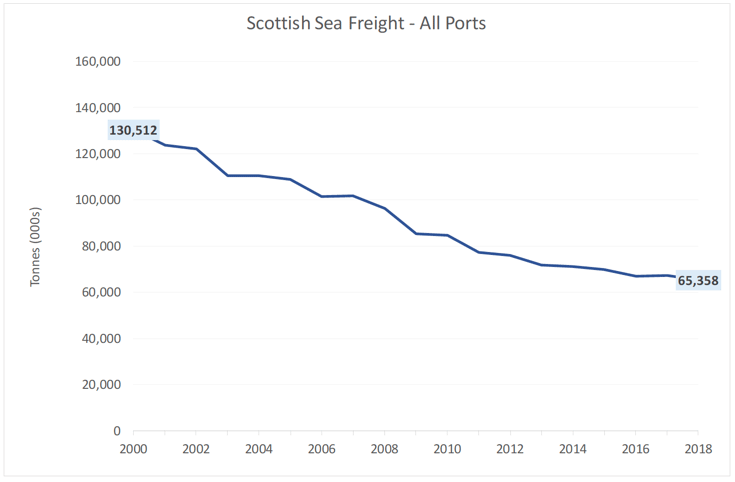
Total Scottish major port freight accounted for 95% of all port freight lifted in 2018.
The chart below highlights the changes in freight volumes by major port over the past decade, and shows that only two ports, Loch Ryan and Peterhead, have seen growth in freight volumes.
Figure 14: Change in freight volumes handled by Scotland's 11 major ports (2008 – 2018)
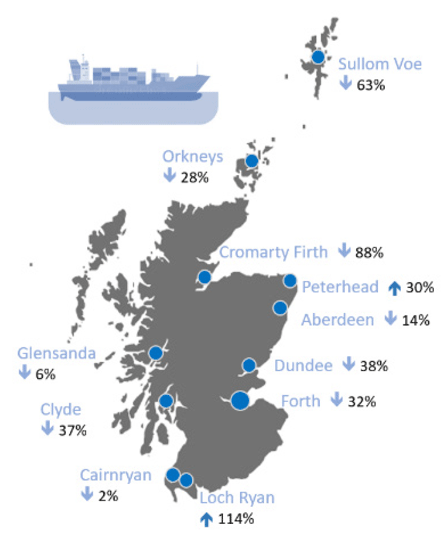
Over the past 20 years, there has been a large shift away from domestic (to and from other ports in the UK) and export sea port freight, while import freight has held up over the period. Despite this, outbound international freight traffic accounted for 33.3 million tonnes in 2018, approximately 54% of major port traffic in 2018.
In terms of share of total sea freight from the major ports, compared to 1998 – when domestic freight accounted for over 40% at 48 million tonnes - domestic freight carried by Scotland's major ports has fallen to 27.7%, totalling 17.2 million tonnes. International imports increased to 11.5 million tonnes in 2018, but has fallen from its peak of 18 million tonnes in 2006.
The 11 major ports connect to over 100 destinations worldwide, including ports in the UK, mainland Europe, and further afield in Asia, South America and elsewhere. The majority of goods handled by Scottish sea ports are outbound (export goods). This is exemplified by Glensanda which only ships outwards (bulk granite aggregates) to destinations in the UK and mainland Europe. The main types[33] of foreign traffic through the major ports in 2018 were crude oil (27.5 million tonnes), oil products (9.8 million tonnes) and other dry bulk (7.7 million tonnes).
In 2018, international traffic through the major ports (imports and exports) totalled 44.8 million tonnes. The split between imports and exports was roughly a quarter and three quarters respectively. Of the international traffic, the Forth[34] and Clyde ports combined accounted for 71% (31.6 million tonnes) of all international traffic through major ports in 2018. This is shown in Figure 15.
Figure 15: Foreign freight traffic through Scotland's Major Ports (Inwards and Outwards - 2018)[35]
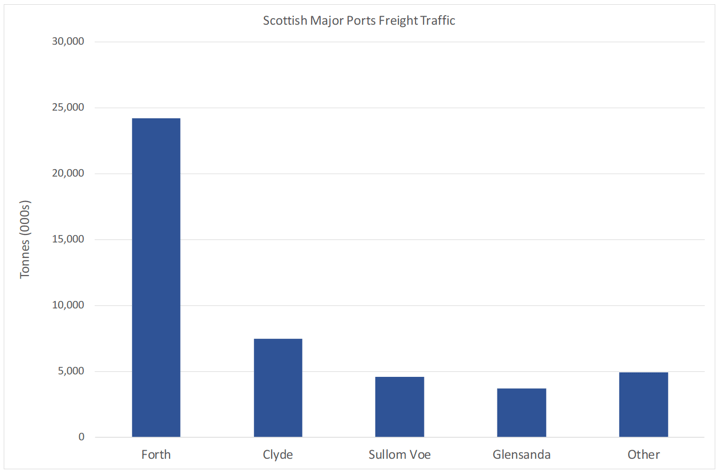
In 2018, the majority of exports handled by Scotland's ports were destined for EU countries. Outward traffic from Scottish major ports to EU countries totalled 22 million tonnes in 2018, two thirds of all outward international sea freight. The EU also accounted for 61% of foreign traffic of all types of cargo in both directions (to and from Scotland).
Although the USA are a major exporting partner for Scotland, being in Scotland's top 3 export destinations by value for each of the past 6 years, in terms of tonnage, the goods moved to the US via port freight shipping represent just 3.5% of 2018's international export total.
Figure 16: Foreign freight traffic carried by Scotland's Major Ports by Country Group, 2018
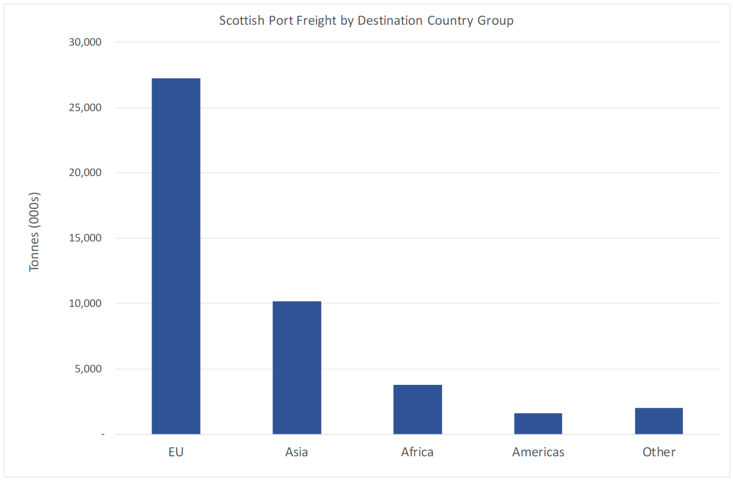
Outside of the EU, Scotland's main sea freight partners were China, South Korea and Nigeria, - predominantly due to liquid bulk shipments in each case. This involved inward bound freight traffic (imports) to Scotland from Nigeria and outward bound freight traffic (exports) from Scotland to China and South Korea. Combined, these three countries alone accounted for over a third of all foreign traffic at major Scottish ports in 2018 at 13.3 million tonnes.
Figure 17 shows Scotland's top 10 sea freight trading countries for both inward and outward traffic. Representation is equally split between EU and non-EU countries, but in terms of tonnage, approximately 60% of traded goods of the top 10 countries, are with EU countries.
The most popular destination for foreign port traffic in 2018 was the Netherlands, with over half (11.7 million tonnes) of all EU traffic destined for the country. Furthermore, Germany and Belgium were also significant freight partners, lifting 4.5 million and 3.9 million tonnes respectively in 2018.
The largest non-EU market for Scottish port freight was China. This was dominated by liquid bulk cargo and totalled over 5.5 million tonnes.
Figure 17: Scotland's Top 10 Port Freight Trade Partners (Inwards and Outwards), 2018
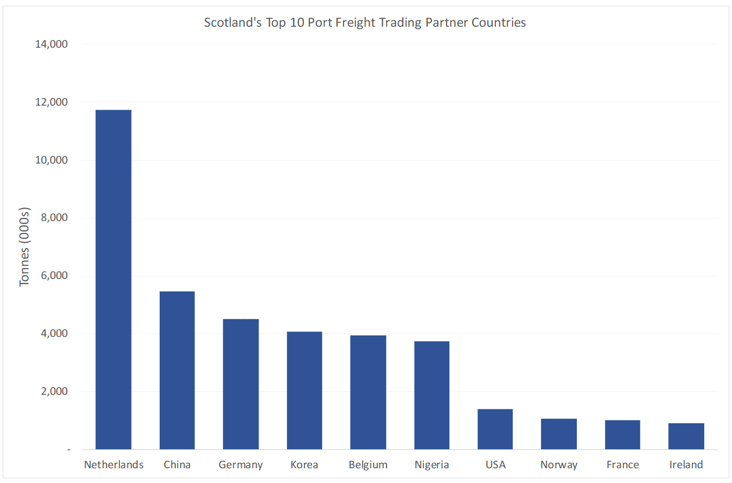
The countries included in the figure above are based on direct journeys to or from Scottish ports. This therefore excludes cargo or freight travelling to or from Scotland via the Channel ports.
In terms of goods, liquid bulk made up the vast majority of freight moved by Scottish ports, accounting for 67% (41.3 million tonnes) of all sea freight moved by major ports in 2018. A further 9.3 million tonnes (15%) was made up of dry bulk. The remaining 18% (around 11 million tonnes) included container cargo and all other types of cargo.
4.4 Road Connectivity
The first edition of Transporting Scotland's Trade outlined Scotland's road network and provided a breakdown of how the network supports the movement of goods in and around Scotland and also abroad.
As has previously been highlighted, approximately 69% of freight in Scotland is carried by road (148.5 million tonnes). The vast majority of this (75% or 111.4 million tonnes) remains in Scotland. In total, only 13% of freight journeys originating on Scottish roads left Scotland for another UK destination, 97% of which had a final destination in England (See Table 1 below).
Scotland-Scotland |
Scotland – rUK |
Scotland - non UK |
Total |
|
|---|---|---|---|---|
Tonnage Lifted |
111.4 |
17 |
0.2 |
148.5 |
|
rUK-Scotland |
Non UK - Scotland |
||
Tonnage Lifted |
20 |
0.1 |
||
Share of total tonnage |
75.1% |
24.8% |
<0.1% |
100% |
The volume of Scottish road freight either bound for or coming from international (non-UK) destinations is a small proportion of this total figure at approximately 0.1% or less than 1 million tonnes. The vast majority of this international freight was exports, with less than 100,000 tonnes of goods entering Scotland (imports) from non-UK countries in 2018, 98% of which came from destinations in the EU.
Scottish Road Traffic
In 2018, the estimated volume of traffic on Scotland's roads was around 48 billion vehicle kilometres, 0.3% more than 2017[37]. Of this total distance, 22% was covered by goods vehicles (light or heavy), accounting for over 10.6 billion vehicle kilometres over the year.
Given the small number of UK HGVs carrying Scottish goods outwith the UK[38], the proportion of freight carriage by these HGVs was naturally also very low. In 2018, of the 14.6 billion tonne kilometres travelled by UK HGVs originating in Scotland, only 241 million tonne kilometres were destined for locations outwith the UK, roughly 1.6%.
This is also the case for inward freight traffic from destinations outwith the UK. Of the 15.7 billion tonne kilometres travelled by HGVs with destinations in Scotland, only 125 million tonne kilometres were travelled by UK HGVs originating outwith the UK, roughly 0.8%.
Although Scottish level data for goods moved by road freight from outwith the UK is difficult to estimate, there are two key goods types which have sample sizes large enough to provide reliable estimates: Food & Drink and Machinery & Equipment. These two good types feature in Scotland's top 5 exporting goods with a combined value in excess of £4.7 billion, so it is not unreasonable to suggest that a proportion of Scotland's exports of food & drink and machinery & equipment travel to overseas markets via the road network.
The chart below shows some of the destinations that Scottish outbound freight travelled to in 2018. Due to the small volume of freight and sample sizes, data is not available for a lot of countries to provide an accurate estimate, therefore the chart below shows those with a significantly large enough sample size for comparison and individual reporting with the rest aggregated together.
The data shows that the countries where data is available (i.e. the sample size is big enough) include countries which feature in Scotland's top trading partners in terms of imports and exports, within a reasonable distance for a HGV driver to travel, so mainly European Countries (EU and non-EU).
While the total tonnage increased in 2018, the proportion shifted with a reduction in 'Other EU' country exports and an increase in exports to 'Other Countries'.
Figure 18: Road Freight – Goods Leaving Scotland by UK HGVs for non-UK destinations, 2017-18
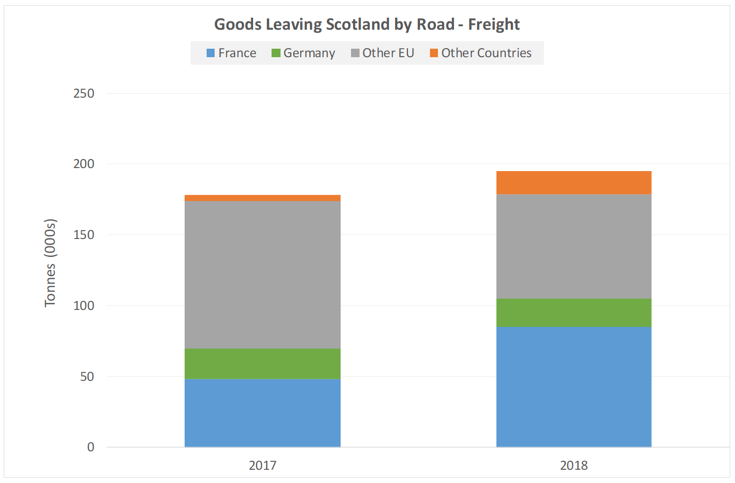
The majority of these HGVs are likely to drive down to the Eurotunnel and Channel Ports to enter continental Europe. Latest data shows that in 2018, there were an estimated 2.5 million road haulage vehicle crossings between Dover and Calais[39]. This is down on the previous year and the first time this annual figure has fallen since 2011. Using this estimate as a proxy, Channel Port crossings by Scottish lorries accounted for less than 0.5% of total crossings in 2018. Although this suggests that total Scottish freight travelling to / from Dover is small, this is a key gateway for Scottish traders to mainland Europe.
4.5 Rail Connectivity
Scotland's railway network[40] consists of 358 stations supporting over 2,400 services each weekday. The network also contains a number of freight terminals with links further afield to the rest of the Great Britain via the east and west coast. Scottish rail routes are used primarily for passenger travel, with 102 million[41] journeys being made between April 2017 and March 2018. The majority of these journeys (92.3 million) both originated and had a final destination within Scotland, further highlighting the importance of Scotland's rail network for internal connectivity. Scotland's busiest stations for passenger travel are Glasgow Central, Edinburgh Waverley and Glasgow Queen Street.
Rail freight plays a significant role in everyday life. A report jointly commissioned by the Scottish Government and the Rail Delivery Group highlighted rail contributing up to £670m in Gross Value Added (GVA) annually to Scotland's economy, supporting up to 13,000 jobs and facilitating up to a further £650m in wider economic benefits.[42]
A wide range of products including supermarket supplies and high street brands move by rail. Key Scottish exports such as whisky, shortbread and bottled water are also major users of rail. Across Great Britain, total freight lifted between April 2018 and March 2019 was 75.4 million tonnes.
Rail freight is crucial to the economy with one in four sea containers arriving at UK ports, being carried inland by rail[43]. The Rail Delivery Group's submission to the Williams Review noted that rail freight delivers around £1.7 billion worth of benefits to Britain's economy and supplies £30 billion worth of goods to customers across Britain each year, including housebuilding materials, clothing and metals. Moving goods by rail rather than road reduces carbon emissions by 76%, benefitting the environment. A single freight train can remove up to 76 heavy goods vehicles (HGVs) from the roads which also cuts down congestion and improves safety[44].
Rail freight is organised differently to passenger rail. Trains are run as 'open-access' operations (i.e. not through a franchise contract) also with stringent controls. Network Rail own and operate Britain's rail infrastructure, including connections to major customers' own private sidings with many of its sites and depots leased to freight train operators.
Network Rail also has responsibility for finding suitable 'paths' (timetable slots) for both freight and passenger services to operate. Freight services across the network are provided by private sector Freight Operating Companies who provide the locomotives and the freight-carrying wagons, and in some cases the facilities to load, unload and transfer to other modes of transport. Logistics service providers often act as intermediaries offering a variety of services including multi-modal distribution, and can manage the whole process for customers.[45]
As highlighted in the first edition, up to 2013, rail freight volumes in Scotland had been declining year on year. In recognition of the importance of rail freight to the Scottish economy, Transport Scotland published Delivering the Goods, Scotland's Rail Freight Strategy in March 2016. The strategy set out a number of actions for all rail freight industry partners to take forward and it informed Transport Scotland's High Level Output Specification (HLOS) which sets Network Rail's regulatory outputs for the current rail control period (2019 to 2024).
The HLOS was published in July 2017 and includes targets to grow rail freight on the Scottish network alongside freight performance and journey time improvements. This has resulted in an industry growth plan (published in March 2019) focussed on achieving or exceeding the growth target.
Figure 19: Scottish intermodal rail terminals[46]
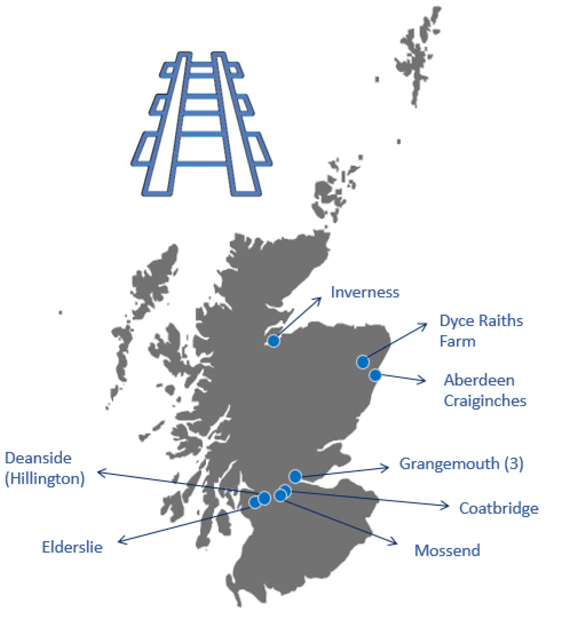
Figure 19 shows the key intermodal rail terminals in Scotland. Scotland's rail freight network carried freight around 430 million net tonne miles between April 2018 and March 2019. This included all commodities (excluding coal) and was only the mileage within Scotland. Looking at the full journey – which would include mileage out with Scotland depending on final destination of outbound freight and origin of inbound freight – over the same period, import and export Scottish rail freight totalled over 1.1 billion net tonne miles.
Scotland's main rail freight terminals are across the central belt. Going from east to west these are in Grangemouth, Mossend (Eurocentral), Coatbridge, Deanside (Hillington) and Elderslie. Figure 20 shows the Current intermodal trade flows running between Scotland and the rest of Great Britain.
Figure 20: Scotland's Current Intermodal Rail Freight Flows
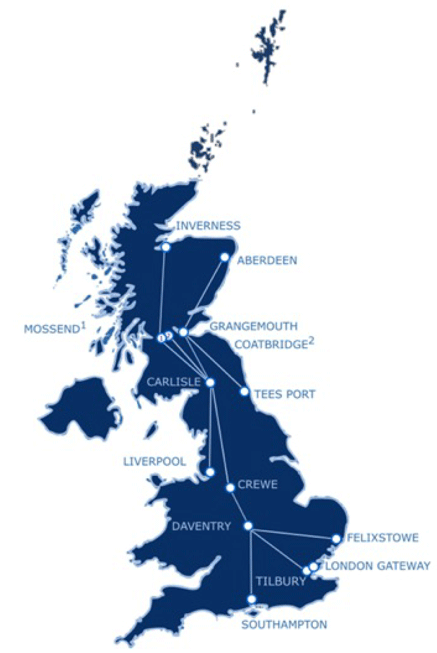
As mentioned before, freight services along these routes are provided by different Freight Operating Companies (FOCs). The figure above only outlines the available routes currently taken. The list of active routes is as follows:
- Grangemouth to Aberdeen, Daventry, Tees Port and Tilbury (via Daventry)
- Coatbridge to Crewe, Felixstowe, London Gateway and Southampton
- Mossend to Inverness, Seaforth (Liverpool), Tees Port and Daventry
The figure above shows that the three central belt intermodal terminals mentioned above, are key to Scottish rail freight down to England and beyond.
Diagram 1 in the Annex shows the current rail freight network within Scotland. The red dashed lines highlight Scotland's strategic rail freight network. This route is a key corridor for Scottish rail freight travelling between the east and west of Scotland. The blue solid lines highlight the core routes of the network. Each of the intermodal rail terminals pinpointed in Figure 19 are along this blue solid route. This route is responsible for the majority of freight travelling through central Scotland.